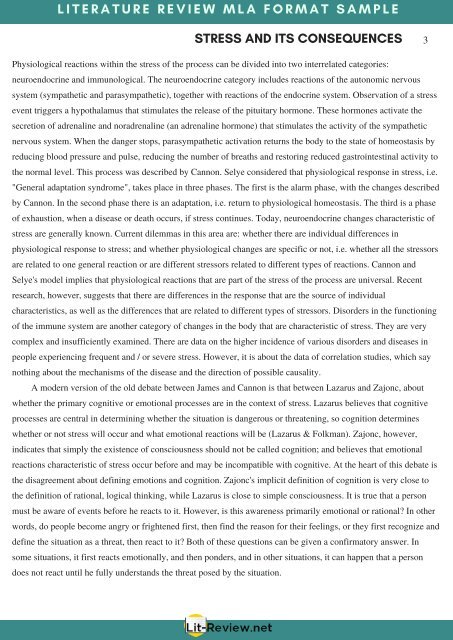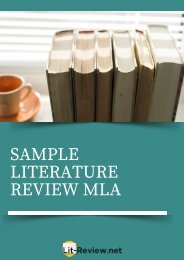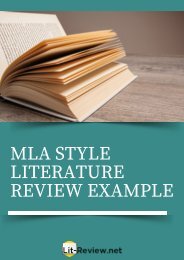Astonishing Sample Literature Review MLA Format
How to get the best astonishing sample literature review MLA format. Geth this info here http://www.lit-review.net/mla-literature-review/
How to get the best astonishing sample literature review MLA format. Geth this info here http://www.lit-review.net/mla-literature-review/
You also want an ePaper? Increase the reach of your titles
YUMPU automatically turns print PDFs into web optimized ePapers that Google loves.
L I T E R A T U R E R E V I E W M L A F O R M A T S A M P L E<br />
STRESS AND ITS CONSEQUENCES 3<br />
Physiological reactions within the stress of the process can be divided into two interrelated categories:<br />
neuroendocrine and immunological. The neuroendocrine category includes reactions of the autonomic nervous<br />
system (sympathetic and parasympathetic), together with reactions of the endocrine system. Observation of a stress<br />
event triggers a hypothalamus that stimulates the release of the pituitary hormone. These hormones activate the<br />
secretion of adrenaline and noradrenaline (an adrenaline hormone) that stimulates the activity of the sympathetic<br />
nervous system. When the danger stops, parasympathetic activation returns the body to the state of homeostasis by<br />
reducing blood pressure and pulse, reducing the number of breaths and restoring reduced gastrointestinal activity to<br />
the normal level. This process was described by Cannon. Selye considered that physiological response in stress, i.e.<br />
"General adaptation syndrome", takes place in three phases. The first is the alarm phase, with the changes described<br />
by Cannon. In the second phase there is an adaptation, i.e. return to physiological homeostasis. The third is a phase<br />
of exhaustion, when a disease or death occurs, if stress continues. Today, neuroendocrine changes characteristic of<br />
stress are generally known. Current dilemmas in this area are: whether there are individual differences in<br />
physiological response to stress; and whether physiological changes are specific or not, i.e. whether all the stressors<br />
are related to one general reaction or are different stressors related to different types of reactions. Cannon and<br />
Selye's model implies that physiological reactions that are part of the stress of the process are universal. Recent<br />
research, however, suggests that there are differences in the response that are the source of individual<br />
characteristics, as well as the differences that are related to different types of stressors. Disorders in the functioning<br />
of the immune system are another category of changes in the body that are characteristic of stress. They are very<br />
complex and insufficiently examined. There are data on the higher incidence of various disorders and diseases in<br />
people experiencing frequent and / or severe stress. However, it is about the data of correlation studies, which say<br />
nothing about the mechanisms of the disease and the direction of possible causality.<br />
A modern version of the old debate between James and Cannon is that between Lazarus and Zajonc, about<br />
whether the primary cognitive or emotional processes are in the context of stress. Lazarus believes that cognitive<br />
processes are central in determining whether the situation is dangerous or threatening, so cognition determines<br />
whether or not stress will occur and what emotional reactions will be (Lazarus & Folkman). Zajonc, however,<br />
indicates that simply the existence of consciousness should not be called cognition; and believes that emotional<br />
reactions characteristic of stress occur before and may be incompatible with cognitive. At the heart of this debate is<br />
the disagreement about defining emotions and cognition. Zajonc's implicit definition of cognition is very close to<br />
the definition of rational, logical thinking, while Lazarus is close to simple consciousness. It is true that a person<br />
must be aware of events before he reacts to it. However, is this awareness primarily emotional or rational? In other<br />
words, do people become angry or frightened first, then find the reason for their feelings, or they first recognize and<br />
define the situation as a threat, then react to it? Both of these questions can be given a confirmatory answer. In<br />
some situations, it first reacts emotionally, and then ponders, and in other situations, it can happen that a person<br />
does not react until he fully understands the threat posed by the situation.





